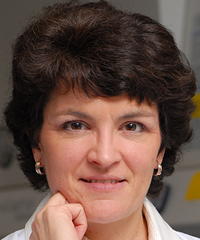Oncology
Multiple Myeloma
High-Risk Multiple Myeloma: Doctor-Patient Discussions
Although we have made significant strides in the treatment of multiple myeloma, patients with high-risk disease, unfortunately, still have much shorter remissions and survival than those who do not have high-risk features. The factors involved in high-risk disease include a patient’s genetics, disease stage, and clinical response to frontline therapies, as well as extramedullary disease. There are also patients who might not have any high-risk disease features at diagnosis but still do not achieve the level or duration of remission that we might anticipate.
Genetic features indicating high-risk disease include del(17p) and TP53 mutations. In addition, we pay particular attention to patients who have amplification of chromosome 1q. The more copies of chromosome 1q someone has, the higher their associated risk. When discussing genetic features of disease, I always assure patients that this is not something that they had any control over or did anything to create. Patients who have extramedullary findings have disease that tends to behave more aggressively. Even if these patients experience a response, those responses are often not durable.
We do our best to explain these high-risk disease–related factors to our patients, all the while maintaining hope and encouragement as we work to continue to improve the therapeutic options for high-risk multiple myeloma. It is important for us to share our current knowledge about multiple myeloma with our patients and to help them understand the biology of their disease. I try to enroll my patients with high-risk multiple myeloma in clinical trials at each juncture when treatment is needed, from newly diagnosed through relapsed and refractory disease. Ideally, we would ensure that those who have high-risk disease enroll in clinical trials as frequently as possible.
Hopefully, we can continue to make advances across the spectrum of treatment. However, it is also important to temper expectations to a degree. Unfortunately, patients with high-risk disease do not always see the same benefits from new therapies as patients whose disease does not have high-risk features.
Bladé J, Beksac M, Caers J, et al. Extramedullary disease in multiple myeloma: a systematic literature review. Blood Cancer J. 2022;12(3):45. doi:10.1038/s41408-022-00643-3
Davies FE, Pawlyn C, Usmani SZ, et al. Perspectives on the risk-stratified treatment of multiple myeloma. Blood Cancer Discov. 2022;3(4):273-284. doi:10.1158/2643-3230.BCD-21-0205
Lyall M, Crawford R, Bell T, et al. Characterizing the patient journey in multiple myeloma: qualitative review. JMIR Cancer. 2022;8(3):e39068. doi:10.2196/39068
Schmidt TM. High or low? Assessing disease risk in multiple myeloma. Hematology Am Soc Hematol Educ Program. 2022;2022(1):349-355. doi:10.1182/hematology.2022000347
Terpos E, Mikhael J, Hajek R, et al. Management of patients with multiple myeloma beyond the clinical-trial setting: understanding the balance between efficacy, safety and tolerability, and quality of life. Blood Cancer J. 2021;11(2):40. doi:10.1038/s41408-021-00432-4
Usmani S. Frontline treatment for high-risk multiple myeloma: personalized [abstract EXABS-198-MM]? Abstract presented at: Eleventh Annual Meeting of the Society of Hematologic Oncology; September 6-9, 2023; Houston, TX.











